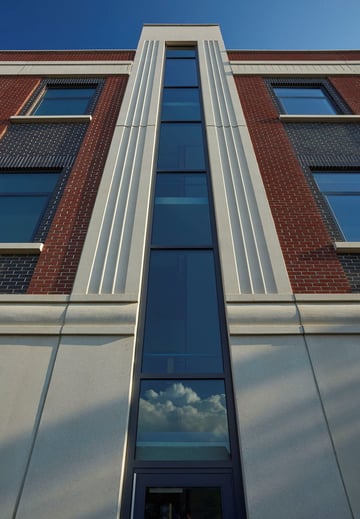Want quick responses to our most asked precast questions? Our blog series, “FAQ Fridays,” is designed to answer your most popular questions, organized by topic and product category. In Part 10 of this series, we discuss Architectural Precast Concrete.
Architectural Precast Concrete
The term Architectural Precast Concrete refers to any precast concrete component that, through application of shape, finish, color, or texture contributes to the architectural form and the finished effect of the structure combining freedom of architectural expression with the economy of mass production. Architectural precast components can be non-loadbearing cladding panels, part of the structural building frame, or small decorative trim between windows or within a brick façade. Refer to the New Classification Categories AA, AB, AC, AD, AT.
In this FAQ video, see precast concrete's incredible versatility and capabilities for museums, multi-family housing, and everything in between!
Can architectural precast be used as a loadbearing element?
Yes. We encourage you to do so. For a minimal additional reinforcing and connection cost, architectural precast concrete can become a terrific loadbearing element.
What finishes provide the best consistency?
A wide variety of finishes are available in architectural precast concrete, ranging from a smooth form or as-cast finish to deeply exposed aggregates. As a rule, a textured surface provides more uniformity than a smooth surface because the natural variations in the aggregates will camouflage subtle differences in the texture and color of the concrete. A medium sandblast finish, for example, generally provides more uniformity and consistency than an acid wash finish. Dividing larger areas into smaller ones with reveals or rustications can also help lessen any variation in texture that might be visible.
What is the largest architectural panel dimension that I can design?
Find the right size and weight for the right product and application: consult PCI or local producers to better understand standards and general “rules of thumb” for every type of precast product.
Rules of Thumb – Shipping Considerations with Precast
- Maximum height of load: 13’ 6” (including trailer and shipping frame height)
- Maximum width without permit: 8’ 6”
- Maximum weight of load without permit: 48,000 lb.
Rules of Thumb – Site Considerations with Precast
- Crane type (mobile vs. tower)
- Crane access and swing from truck to building
- The ability of trucks and cranes to move under their own power with easy movement on stable, solid, access roads
- Side access (open to all sides or limited to two)

What is the thinnest panel possible with precast cladding?
Practical considerations may impact panel thickness such as providing concrete cover and to accommodate aggregate sizes. If the panel requires no reinforcement, 3” thickness may be possible for cladding products although generally a 4” thickness is the practical minimum thickness for a cladding unit. Mild reinforced panels are more typically 5-6”. Other considerations include the span of the panel, incorporation of false joints, as well as lifting and connection devices. We highly recommended you consult a local PCI-certified precast producer for best panel design options, budget estimates, and project outcomes.
Can precast cladding be insulated?
Yes. Traditionally in the past, precast cladding, load bearing on building structures have been solid panels attached to the structure. Thermal barrier applied separately in the field with batt, rigid, or spray-on types of insulation applied to the backside of panels in the field.
Precast cladding can be an insulated sandwich type product, and usually an overall net trade savings. Through the years of our industry innovations, there are components within the panel and basic parameters established in precast design to accommodate full, continuous thermal break precast insulated panels to “clad” or enclose a building.
What is the optimum joint size between panels?
The recommended precast panel to panel joint width for architectural projects is 1/4". It is common to have ¼” – ½” caulk joints from Window to any substrate, ¼” being most common. This is the minimum nominal joint width needed to adequately account for production and erection tolerances and still maintain an effective minimum joint width that can be caulked. A 30' long spandrel panel is allowed, per PCI tolerances up to a 1/4" variation in length. Keep in mind that of 3/8" is the minimum width that caulk suppliers will warrant. It is also important that the joint between precast panels and window frames also maintain the same nominal joint width.
What are the maintenance requirements for joints?
The Architectural Precast Concrete Panels themselves will not require maintenance from a joint waterproofing perspective. It is all about caulking and sealants.
Consult the specified waterproofing manufacturer to furnish standards for maintenance.
Should sealers by used on precast? If so, when should they be applied?
Sealers are often specified to improve the weathering characteristics of precast panels, especially in urban areas where the building may be subjected to airborne industrial chemicals. Sealers can also help facilitate the cleaning and maintenance of the panels if they should become dirty. When sealers are used, they should be applied in the field, after all the joints are caulked, repairs are made, and cleaning is complete. Otherwise, it is likely that the panels will have to be recoated in spots, which could lead to inconsistencies in color and finish.
Sealers are also a solution to remedy minor non-structural cracks in the surface of precast panels.
What is recommended as a preferred distance from the architectural precast panel to the edge of slab?
It is recommended that 1 ½” to 2” be allowed between the edge of slab and the backside of the precast panel to account for tolerance in the slab as well as the precast. The slab edge location should be clearly defined on the contract documents. Pay particular attention to slab edge conditions along skewed or curved building edges as these areas are often the areas that cause the most difficulty during layout.
What is recommended as a preferred distance for the connections to structure?
12” or less, from the backside of panels to center of structural support connection (i.e. steel or concrete column or beam).
What about interior dimensions?
It is important to consider tolerances when designing the interior wall finishes and locations. For example, if inadequate space is left between the back of the precast panel and the inside face of the interior finish, connections may become exposed to view. Allowing at least an extra 1/2” between the back of the drywall and the theoretical back edge of the connection hardware is strongly recommended. When the distance between the back of the precast and the interior finish does not accommodate this, connections may have to be recessed. It is also a good practice for the engineer to specify the allowable locations for slab recesses and to provide reinforcing details to account for this.
What are panel-to-panel and other tolerances for architectural precast?
Manufacturing and erection tolerances apply to precast concrete just as they do to other building materials. Tolerance is defined as a permissible variation from a specified dimension. A tolerance can be expressed as an additive (+) or subtractive (-) variation from a specified dimension or relation or as an absolute deviation from a specified relation. Tolerances define realistic limits for size and shape within which the precast concrete units must lie and must satisfy the designer’s intent while ensuring the constructability and economy of the building system. Three groups of tolerances should be established as part of the precast concrete design: product tolerances, erection tolerances, and interfacing tolerances.
Tolerances and interface conditions are best handled by the design team, general contractor, or other entity having the contractual authority necessary to specify, coordinate, and control interfacing requirements of other trades that adjoin the precast concrete construction. While the responsibility for specifying and maintaining tolerances of the various elements may vary among projects, it is important that this responsibility be clearly assigned and communicated to all members of the project team. The tolerances must be reasonable, realistic, and within generally accepted limits. Some manufacturing and erection costs are directly proportional to the tolerance requirements. It is more economical to design connection and interface details with maximum flexibility and keep tolerance requirements as realistic as possible.
ACI has adopted the PCI Tolerances as a consensus standard in ACI ITG-7, “Specification for Tolerances for Precast Concrete” which is referenced by ACI 301 “Specifications for Structural Concrete.”
Tolerance resources available for reference and download include:
- MNL-135 Tolerance Manual for Precast and Prestressed Concrete Construction
- Designer’s Notebooks: Envelope Tolerances for Architectural Precast
 What does architectural precast cost?
What does architectural precast cost?
Understanding architectural precast costs is essential to designing affordable façades that enhance the
overall building design while meeting the owner’s budget. Understanding the architectural precast concrete manufacturing process can help achieve design goals and control costs. During a project’s conceptual stage, the designer has many variables to consider that affect precast concrete cost. A local precaster can assist with preliminary design and budget estimating early in the project’s design phase. Piece size and repetition typically have the most significant cost impacts. In addition, material selection, textures, surface geometry, cross-section, erection details, jobsite access conditions, and connections can affect cost. The custom, sculptured designs that are possible with precast concrete may be achieved within a limited budget by selecting appropriate aggregates and textures combined with repetitive units and efficient production and erection details. Input from the precaster can be beneficial in developing options for creating an economical design that also satisfies the designer’s aesthetic requirements.
Engaging a precaster early is critical to establish your budget
During preliminary design, a precast concrete project can be preliminarily budgeted on a square-foot (m2) basis. Although this provides a starting point, it is recommended that the designer seek additional estimating assistance from a precaster. Working with a precaster on a specific project will help determine a final budget that is more accurate than a ballpark price per square foot (m2). A cost per square foot (m2) can be misleading to general contractors and architects because square foot (m2) quantities are calculated differently from precaster to precaster, depending on the take-off procedures. Total work scope requirements such as site restrictions, work scope inclusions, and detail manufacturing requirements are initially unknown. Budget pricing from local precasters, submitted in writing and including assumptions, will aid design efforts from schematic design through final contract documents. As a project evolves from preliminary sketches through working drawings, the precaster(s) should be informed of all changes. Pricing accuracy depends on the information provided to the precaster’s estimator. This discussion on design economy uses square foot (m2) prices to describe a designer’s precast concrete options. All prices are for relative comparison only and should not be used to make decisions for individual projects. The design and detailing of the precast concrete units should reflect good production concepts. Consultation with a precaster at an early stage will be helpful.
What is the master mold concept and how does it impact panel design and project cost?
A key element to cost-effective production is minimizing the number of molds and mold changes, and maximizing the number of castings from each mold, particularly if the molds have shape. Efficiency and economy are achieved by making it possible for similar, if not identical, shapes to be produced from the same basic (master) mold, and by minimizing the time required to disassemble a mold and reassemble it for the manufacture of the next piece. Careful planning is necessary to achieve good repetition in the design without sacrificing design freedom. For example, many design variations may be developed by incorporating two basic architectural panel types (spandrel panels and floor-to-floor panels with openings) on the same structure. These panel types may also be varied with different architectural finishes and textures. Attention should be focused on the overall geometry of the structure, not only on the shape of the panel. The cost of complex shapes becomes economical through repetitive precasting as the investment made in fabricating a complex mold is amortized over a greater number of pieces. Occasionally, due to production schedule compliance, a precaster may need to construct multiple molds to produce the required number of panels within a certain period.
Want to work with precast concrete in your upcoming projects? Explore helpful tools, detailed information on working with precast, and expert guidance to support your next project in our Solutions Center.





